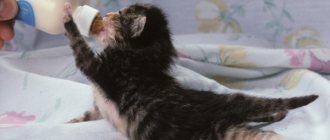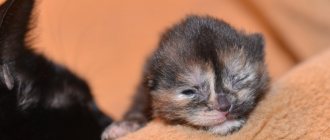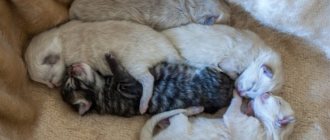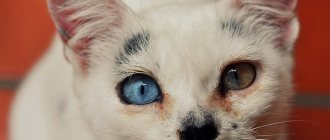Development of kittens (+ table)
Development of kittens (+ table)
Kittens are born small (weight 60-115 g, average body length 12 cm) and completely helpless, blind and deaf; all they can do is find their mother’s nipples, sleep and suck.
They cannot even get rid of excrement products on their own; to do this, the cat licks the appropriate places for them and eats their feces. However, they grow and develop quickly, and watching this process is a fascinating activity! Already a few days after birth, kittens begin to “knead” their mother’s belly with their paws, stimulating the secretion of milk (I wonder who taught them this?) They try to crawl, helping themselves with their front paws. At the age of seven days, a kitten can already crawl several tens of centimeters. At approximately 10-14 days of age, kittens' eyes begin to open.
. At this age, the eye color of all kittens is blue; it will change to the final adult color (“rebloom”) later, at the age of 3 months. At the same time, the ear canal opens and the kittens begin to hear.
In the third week
of life, kittens begin to erupt milk teeth (later they will be replaced by permanent ones). Their vision and hearing improve and they begin to explore the world around them. By the end of the first month of life, they can sit, move quite confidently and learn to play with each other. At one month of age, kittens become interested in trying foods other than their mother's milk.
Kittens older than 4 weeks become even more active and strive for independence. If before this they mainly explored their “nest,” now they are trying to get out of it. The cat spends a lot of energy maintaining order in the family and putting the children in their place. But the activity of kittens is growing by leaps and bounds, although at this age they still do not stray far from their mother. At this time, you need to place a tray next to the nest so that, following the example of their mother, the kittens become accustomed to cleanliness and neatness. Kittens that have been taught to do their business in the litter box by their mother cat will not have any problems with the toilet in the future.
From a month to one and a half months, kittens are very active, learn to lick themselves, play with each other and with their mother, and begin to eat solid food. There is an idea that at this age they can already be taken away from their mother and transferred to new owners. However, this idea is fundamentally incorrect. It is at the age of 1-3 months that kittens watch their mother and learn everything from her. Up to two months, the cat continues to feed the kittens with her milk, which provides them with good immunity to diseases. Therefore, it is not recommended to give away kittens before 2.5-3 months.
.
Complementary feeding of kittens is carried out as follows
. At the age of three weeks, kittens can be offered to drink milk from a saucer (about one teaspoon). Then you can offer some kitten food (see feeding kittens here). After a couple of days, a little baby food should be added to dairy foods, and after another week, it is recommended to replace one daily feeding with a small amount of canned meat. One month old kittens are fed approximately 4 times a day, in addition to their mother's milk. Feed portions are gradually increased. At one and a half months of age, a kitten should eat approximately 3-4 teaspoons of food per feeding.
At three months
kittens change their eye color to the color they will have throughout their lives.
At five months
, baby teeth fall out and are replaced by permanent teeth.
After five months of age, the “young and early” cats begin to mark their territory, and the “earliest” cats may begin their first heat. At six months, teenage kittens have already formed and become independent, but they will still be growing up until they are a year old.
4–5 months: adolescence
The nutrition of a growing pet should consist of kitten food, which contains substances necessary for normal development. It is recommended to feed animals about 5 times a day. By the end of the fifth month, a three-times-a-day diet is established.
The appearance of the kitten changes, its body increases in size, its muzzle and tail lengthen, and its paws stretch. The pet can already be mistaken for an adult cat, he plays less with toys, sleeps more and strives to communicate with people. At 5 months, the kitten’s baby teeth begin to fall out and permanent teeth begin to grow.
At what age will a kitten begin to see?
If your cat has given birth, you definitely need to know when the kittens' eyes open. Many owners do not know this, get scared and decide that sick, blind kittens were born. In fact, due to the peculiarities of their physiology, these animals do not begin to see immediately after their birth. You will learn everything about when kittens open their eyes and at what age in our article.
When kittens open their eyes and other stages of their development from birth to one month
So, instead of one fluffy miracle, there are many in your home now. Two? Three? Six? Your cat has given birth and, being a happy mother, spends her days in a box with her family. And the owner has more troubles and, of course, questions. Those of them who have never dealt with newborn kittens before, of course, least of all thought about what newborn “babies” look like and what they can do: when they open their eyes, at what age they begin to hear, etc. Let’s figure it out together in what changes occur with babies in the period from birth to independence.
Newly born seven days
A newly born kitten cannot see, cannot hear, and cannot walk. It is extremely difficult for him to even crawl, and he does it very slowly. But what he can do very well is eat. Yes, yes, this is very important, because in order to grow, develop and gain strength, this is necessary first of all. In the first days, a newborn kitten drinks about 5-10 ml of milk per meal, and the number of feedings can reach 10-12 times a day.
By the way, senses such as touch and smell are developed in babies from birth. Kittens' body temperature is lower than that of adult animals, and thermoregulation is imperfect, which is why they really need the body warmth of their mother cat.
Second week of life
This time is a turning point in the baby's life. This is the period when kittens open their eyes, but not only. This same week, babies begin to hear and their ear canals open. Most often this happens on the 9-10th day. When exactly do kittens open their eyes? This usually happens on the 7-12th day. It has been noticed that in cats, the eyelids begin to diverge a little earlier than in seals. Experts also say that short-haired animals begin to see earlier than their long-haired counterparts. There is an interesting point: when kittens open their eyes depends on the breed of babies, for example, in Ragdoll cats this can only happen by the 14th day. And in representatives of the Devon Rex breed, the eyes can open as early as the 5th day.
Of course, in the first hours and even days when kittens open their eyes, they still see poorly. They only distinguish between light and shadow. The eyelids do not separate immediately, but gradually. It often happens that one eye has already opened completely, while the other is still only half or completely closed. They remain cloudy for several days, but can remain blue for up to one and a half to two months.
The little pets cannot stand yet, but they crawl around the box quite quickly.
During this period, the kittens cut their first teeth (from about the 12th day), they will have the entire set of milk teeth by one and a half to two months.
Third and fourth weeks
When the kittens' eyes open, they are surprised to discover that the world is much more interesting, larger and more colorful than the one they knew before. Curiosity is an important quality that allows a baby to explore the environment. Just at the end of the third - beginning of the fourth week, the kitten has the opportunity to realize it. He already knows how to stand, staggering on unsteady legs, and soft claws can nevertheless help the baby maintain balance. Cat babies begin to crawl vigorously and try to climb out of their box.
They have already established independent defecation and urination. Before this, the mother cat licked each baby several times a day, massaging the tummy, the only way he could defecate.
From this age, kittens can be fed cottage cheese with eggs, milk, and tiny balls of minced meat. However, if the cat has enough milk, the babies may refuse to eat.
At the age of one month, a healthy kitten is a cheerful, active, terribly curious creature, poking its little nose everywhere. He has soft, clean fur. And the kitten’s bluish eyes should be free of any discharge. The baby shows a keen interest in food and defecates regularly. He is not shy, is not afraid of people, strives to play with other kids and objects, and “harasss” the cat by climbing on it.
At what age do eyes open?
It is very difficult to say exactly how many days later kittens open their eyes. Any experienced cat lover will confirm that every baby raises their eyelids at different ages. The difference, even among babies from the same litter, can range from several hours to several days.
On average, many kittens open their eyes 1-2 weeks after birth. It has been noticed that cats usually open their eyes faster than cats. Time is also influenced by genetics - researchers are inclined to believe that this is a hereditary trait.
The breed of the kitten also matters a certain amount. Some of them mature faster than others and begin to see earlier. Thus, one of the earliest is considered to be the Devon Rex, which usually raises its eyelids 4-5 days after birth. And some kittens open their eyes after birth within 2 days. In turn, the popular Ragdoll breed often opens its eyes only after two weeks.
Therefore, you should study such characteristics of your cat breed before lambing occurs. To know how late your eyes will open.
Features of development in the first week
Kittens develop especially rapidly in the days after birth. After birth, he weighs no more than 100 grams and gains about the same amount in the first week. Underweight or excess weight directly affects development, so you need to monitor it and regularly weigh your pet.
During the first 3 days of life, as a rule, the umbilical cord falls off, which the cat can care for independently. But in order to prevent the occurrence of inflammation, kittens are recommended to treat the umbilical cord in the first days of life with a weak solution of potassium permanganate.
A newborn kitten is always blind and begins to see only after three weeks from birth. Few people know such a feature as congenital deafness, which disappears only by 5 days after birth. A deaf baby does not even respond to his mother's voice.
It is especially important to arrange a place for the cat in advance so that small kittens during the period of deafness can easily find their mother . The development of kittens from birth occurs very rapidly; it is during this period that he receives his first food in the form of mother's milk, which ensures that all necessary microelements and nutrients enter the body. Natural nutrition is very important for the development of a kitten, since it also includes antibodies that the baby needs to form immunity.
Although the baby does not see or hear in the first days of his life, he perfectly uses his sense of smell, with the help of which he identifies his mother. Kittens are born with a sense of smell that allows them to find a cat, even if it is within a radius of 60 centimeters from the kitten. In order to ensure the proper development of the kitten, it is necessary to prepare a place for the cat in which drafts and sudden changes in temperature will be completely excluded. This will not only protect the baby from colds, but also provide comfortable conditions for growth.
Possible complications
There are a number of complications that can happen to kittens during the period they open their eyes and delay this process. Some of them are quite dangerous, while others go away on their own after some time. The most common is ankyloblepharon.
Ankyloblepharon
This disease is a partial or complete fusion of the eyelids that occurs when the eyes open. It may also be due to their incomplete splitting in the kitten. This disease does not pose any particular difficulties for modern veterinary medicine, as it can be treated quite effectively.
What to do?
If you notice that the kitten does not open its eyes for too long - more than 10 days, then the first thing you need to do is examine the baby. If his condition is generally normal, and there are no visible disturbances in eye development, then you can wait a few more days. In case of problems, you may notice inflammation in the kitten's eyes.
How the eyes open
The opening takes place in several stages. At first, the animals begin to raise their eyelids. A small crack appears. It occurs either along the entire length of the eyelids or in one corner. The pupils can already be seen, but they are still cloudy. After a couple of days, the kitten opens its eyes completely.
But for the first few days, babies see almost nothing, only light and shadows during the day. Only towards the end of the first month of life does the kitten begin to see. Then the baby will actively explore the world around him and crawl. But his iris color is not yet final. Most cats are born with blue eyes and only then do they acquire their permanent color.
In order for the whole process to go without unnecessary problems, it is necessary to make it as natural as possible. Remember that babies are very vulnerable to infections and other threats. You need to protect your small pets from them.
Fourth week
By the end of the first month of life, the kitten already has milk teeth - it’s time to introduce complementary foods and start drinking water. A kitten at this age is quite socialized, plays with pleasure with its brothers or sisters, and repeats the behavior of its mother.
He still doesn’t know how to run fast, but he walks with an independent and full of confidence look, although he sometimes skids when turning.
It's time to think about the tray. It is placed next to the nest so that the kitten begins to get used to it.
By the end of the first month of life, you can play with the kitten, pick it up, stroke it more often - simple manipulations will help the baby get used to the person and make it tame faster. Don't forget about helminthization: now is the time for it.
When kittens open their eyes: how many days after birth
A new addition to a cat family is a good event, because it is a joy not only for the cat itself, but also for its owners. Little fluffy balls, with their helplessness, make people want to protect them as if they were their own children. At first, the only reference point for babies is their mother, but when the kittens’ eyes open, a new stage in learning about the wonderful world begins. And although the mother cat must take care of the kittens, the owner is obliged to monitor the growth of the babies, periodically weighing them and observing when their eyes begin to open, ears rise, and teeth erupt.
Why are kittens born with their eyes closed?
During pregnancy, a cat bears offspring for 55-60 days, the babies are born absolutely helpless and defenseless. On average, a domestic cat gives birth to three to eight kittens (primiparous cats have fewer). Babies can only feel the warmth of their mother and need her love and care more than ever. The first thing kittens begin to react to is the smell of warm mother's milk. Newborns still cannot do many things: see, hear, empty themselves, control their body temperature.
A newborn kitten needs its mother more than ever
Many mammals are born blind, and there is an explanation for this. If the kitten’s eyelids were not closed at birth, then particles of dust and dirt could get into the eyes, which would negatively affect the baby’s vision. There is another reason: if a cat carried kittens longer than usual in order to later give birth to them more independent, she would risk her own life, because it is inconvenient to carry offspring growing every day in her stomach. Wild cats also give birth to babies in burrows, where sand can fall on the newborns’ eyes, and crawling all over the nest, the kittens could injure their eyesight with a twig or stone.
Additional Information! In horses, for example, everything is different: a mare’s pregnancy lasts 11-12 months, but one foal is born sighted and within a few minutes is on its feet and walking.
Why with open
Most often, only sphinxes can be born with open eyes; in other cases, the birth of babies with open eyes is the result of a disorder during pregnancy. It looks a little strange or even scary, but you shouldn’t immediately rush into panic or sign the little ones’ death warrant. In this case, you need to move the cat with the litter to a dark place and protect the delicate tissues of the eyes from mechanical damage and light for two weeks, since small kittens do not yet know how to blink. You can even trim the claws of littermates so that they don’t accidentally scratch such a baby’s eyes. After fourteen days, eye formation will return to normal, and the baby will grow up sighted and healthy. If the situation has not improved or even worsened, then it is necessary to urgently contact a veterinarian, as vision-threatening diseases leading to complete blindness are possible.
To moisturize the cornea, it is best to use a special gel “Vidisik” (sold in a regular pharmacy). The application scheme is simple: wipe the kitten’s eye with a sterile napkin, apply one drop of gel and gently massage the eye (carefully place two fingers on the edge of the lower eyelid and move in a circular motion to the other side), and then repeat the above algorithm with the other eye. It will be enough to carry out this procedure three times a day to maintain an appropriate level of humidity. Sometimes breeders recommend covering the baby's eyelids with an adhesive plaster, but this may not always help. It is enough just to keep the vulnerable cornea from the harmful effects of bright light and keep it from drying out, and then the visual organs themselves will begin to form as they should.
When do kittens' eyes open after birth?
About what day do kittens open their eyes? On average - by 5-10, and they do not do it in an instant. First, the slits will widen, and the eyelids will gradually begin to separate from each other, and after a couple of days they will open completely. Sometimes it happens that first one eye opens, then the other. A few days later the baby will learn to blink.
How many days after birth
At this time, the organs of vision are still developing, so melanin, which determines the color of the kitten’s eyes, has not yet begun to be produced, and the color of the shell will first be gray-blue. Only by six months will the final eye color, determined by heredity, gradually develop.
From eight months to a year
It is difficult to call a cat at this age a kitten - it is already a fully formed animal, capable of reproduction. Despite this, it is not advisable to mate pets: they only look like adults, but they will not be able to produce full-fledged offspring.
Physical activity decreases, but this does not mean that the cat sits on the sofa all day long: they will find time for both games and relaxation.
Weight gain slows down, and by the age of one year, growth stops altogether, although the body will begin to grow stronger and form before the age of two and a half. Closer to the first birthday, the kitten is gradually transferred to adult food.
Watching a kitten develop is always an interesting and exciting activity. Seeing your baby grow and develop is an incomparable pleasure. Love your pets and they will love you back!
Eye opening depending on cat breed
Maine Coon
The Maine Coon is one of the most popular cat breeds, known throughout the world for its impressive dimensions. Sometimes cats of this breed reach a weight of 15 kilograms. Maine Coons belong to that group of breeds whose kittens open their eyes no earlier than two weeks later. After this point, it is important to regularly wash your eyes with chamomile infusion or black tea for some time.
In a British cat
The British are sophisticated and sophisticated cats that make excellent company for any person. Like all kittens, babies of this breed can sense the level of light in the first days, but only between the 6th and 14th days of life will their eyes open. In this case, it is recommended to keep the nest in twilight and care for the growing babies.
And other breeds
As mentioned earlier, the trend is quite simple: kittens of long-haired breeds open their eyes much later than short-haired and hairless ones. Based on the day the eyes open, scientists distinguish several groups of breeds: hairless and Siamese, which become sighted earlier than others; short-haired, whose eyes open for up to two weeks; large breeds and long-haired with the slowest development.
More facts about eye opening in kittens:
- Sometimes sphinxes are born with their eyes open, but in this case they need special care in the first week. Typically, Sphynx cats begin to open their eyes 3-4 days after birth;
- graceful and graceful cats of Siamese and other “oriental” short-haired breeds open their eyes on the 4-5th day;
- when Abyssinian kittens' eyes open, they are already 4-5 days old;
- Scottish Fold kittens are slightly fluffier than shorthaired kittens, so they begin to open their eyes at 4-7 days. This is due to the presence of a soft and thick undercoat;
- colorful Bengal babies open their eyes on the 10th day of life. But bobtails tend to lag a little. Their babies begin to open their eyes only at 8-10 days;
- in Siberian and Persian babies, such an important event occurs on the 12th or even 18th day of life;
- fluffy and huge ragdolls begin to open their eyes only 15-17 days after birth.
The day the eye opens varies depending on the breed of the kitten.
Features of breeds
The breed of cat also affects the time when kittens first open their eyes:
- In this series, the “foremost” are the sphinxes. Their cubs may already be born with open eyelids. As a rule, representatives of this breed begin to see clearly on the third day.
- Thai and Siamese babies gain sight between the third and sixth days of their stay in this world.
- In Siberian cats, the process begins 5-7 days after birth.
- During this period, Persians also become sighted.
- British babies are helpless until the 6th day of their life, and sometimes longer.
- Oriental cats also gain vision on the 6th day.
- The original record holders in this area are ragdolls, whose eyelids become unstuck no earlier than three weeks of age.
- Scottish “fluffies” begin to open their eyes on the fifth to eighth day, finally gaining sight only on the 14th day.
Interestingly, according to statistics, girls acquire vision earlier than boys, and representatives of long-haired breeds lag behind short-haired and hairless cats.
Also, often the eyes of the first kitten born open earlier than the others.
The entire process of opening the eyelids does not occur in one day, taking up to three days.
Scottish kitten
The opening begins from the inside of the eye. First, a small gap is formed, which gradually increases and reveals to the world a dull blue iris.
But that is not all. Only after 5-10 days will babies gain the ability to see the outlines of objects. Therefore, for the first time after opening the eyelids, it is important to ensure that the kittens stay in a semi-dark place. Otherwise, the bright light may damage the developing pupils.
When do kittens start to hear?
Hearing, like vision, is an integral part of a cat, because thanks to its acute and sensitive hearing it can hunt. Newborn kittens are blind and deaf due to their still poorly developed nervous system, so they are completely and completely dependent on their mother. Kittens learn to hear earlier than when they begin to open their eyes. This mainly happens on days 5-8, as the ear canal gradually begins to open. At first the baby's ears are flattened, but then they will rise.
Important! During the period of hearing formation, it is necessary to provide the kitten with peace and quiet.
As with vision, the rate at which a kitten develops depends on what breed it belongs to. Often, kittens of short-haired breeds begin to see and hear faster than their fluffier counterparts.
At first, kittens only sleep, sometimes waking up to eat. For this reason, lack of vision does not affect their life activities. After some time, when the kittens open their eyes, they become mobile and active. If the owner takes part in caring for the babies, all his efforts will pay off with the invaluable trust of the cat.
Development from the fourth to the sixth month
During this period, it is recommended that he trim his claws for the first time; it is necessary to monitor the following indicators:
- height, which will depend on breed and gender;
- weight, which must be at least 1.4 kg;
- constant activity and good socialization.
Until six months, it is not recommended to give the baby food that is intended for adult cats, as it will not provide the necessary development and the intake of all necessary microelements.
Up to six months, it is recommended to adhere to five meals a day, which ensures good functioning of the gastrointestinal tract and stable development of your kitten. At the end of 6 months, the baby's teeth will begin to change. This age is most optimal for castration. It is advisable to carry out a third deworming in order to eliminate the presence of parasites in your pet’s body. In the sixth month, it is recommended to switch the baby to three meals a day, which corresponds to his level of development.
Possible problems and methods for eliminating them
You can worry about and do anything about a kitten’s unopened eyes only after 21 days of age. Until this moment there is no particular reason to panic. But to be on the safe side, after the second week of development, the babies’ eyes are periodically examined. A simple rule will allow you to notice possible deviations in time.
Problem #1: Eyelid Fusion
Initially, carnivores are born with eyelids fused, but by two to three weeks of age they should open. If by this time the gap has not appeared, the eye sockets look swollen, pus accumulates in the corners of the eyes and on the eyelids themselves, then it’s time to sound the alarm.
With partial fusion, a gentle massage with gradually increasing stretching will help. The peels are pre-soaked with drinking tea. After the procedure, the edges of the eyelids are lubricated with boric alcohol.
If the upper and lower eyelids are completely fused and firmly attached, surgery will have to be performed by an experienced veterinarian. The work is not difficult, but requires care and caution:
- To begin with, novocaine is instilled into the conjunctival sac for pain relief.
- After a few minutes, the fusion line is cut with a sterile and sharp scalpel.
- After this, for another two or three days, the edges of the eyelids are smeared with boric petroleum jelly and the eyes are washed with saline solution to prevent re-sticking.
Problem #2: conjunctivitis
The eyes may not open as a result of conjunctivitis, which develops against the background of an infectious process or some kind of injury, for example, accidental scratching by one of the brothers or sisters. The disease is accompanied by swelling of the eyelids, their sticking together due to dried discharge of a dirty brown color.
What can be done:
- The eyes are washed daily several times a day with a weak solution of tea or ordinary boiled water. This will help to first soften and then completely wash away the pus that prevents the eyelids from opening.
- Instead of sleeping tea leaves, you can use special preparations. Ask your veterinarian which drops to take.
- Usually, after a couple of days of simple therapy, the eyes return to normal and the kitten feels great.
- If the process is prolonged and pus continues to be released, then the discharge is sent to the laboratory to identify the causative agent of the pathology.
- The specialist chooses further treatment based on the analysis results.











